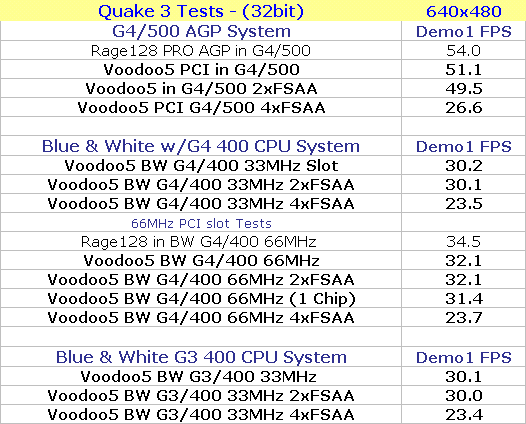 |
|||||||||||||||||||||||||||||||||||||||||||||||||||||||||||||||||||||||||||||||||||||||||||||||||||||||||||||||||||||||||||||||||||||||||||||||
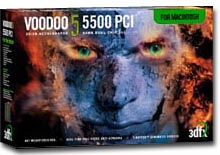
Review: 3dfx Mac Voodoo5 5500 PCI Graphics Card |
|||||||||||||||||||||||||||||||||||||||||||||||||||||||||||||||||||||||||||||||||||||||||||||||||||||||||||||||||||||||||||||||||||||||||||||||
|
|
|||||||||||||||||||||||||||||||||||||||||||||||||||||||||||||||||||||||||||||||||||||||||||||||||||||||||||||||||||||||||||||||||||||||||||||||
|
|
|||||||||||||||||||||||||||||||||||||||||||||||||||||||||||||||||||||||||||||||||||||||||||||||||||||||||||||||||||||||||||||||||||||||||||||||
| Game Performance | |||||||||||||||||||||||||||||||||||||||||||||||||||||||||||||||||||||||||||||||||||||||||||||||||||||||||||||||||||||||||||||||||||||||||||||||
|
[1.08 Driver/ROM Update: On 9/22/2000 3dfx released a 1.08 driver update (with ROM update as well). See the updated Genesis (9500 based) system tests that show both VSA-100 chips are now enabled.
Note: Just as I had finished writing this original review Bryan Speece of 3dfx called to say they had found one possible reason for some of my results. He said based on the 1.0 results last night they wrote a small application to test fill rates in 'fastest' mode (dual processors) vs FSAA and noted about 80MP/sec less fill rate in 'fastest' mode, indicating that mode is not running at full efficiency. This may be one reason for the fact I saw similar single chip vs dual chip performance (even in 2D) and the often close scores on 2xFSAA vs non-FSAA modes. (These sorts of baffling results cost over 2 days of re-testing as I hesitated to post results that logically made absolutely no sense.) The fix for this inefficiency should boost performance and hopefully will be available by the time retail cards arrive to end users. Preface: I won't even begin to try and explain some of these results, which in some cases make no sense logically. I can only assume it's due to the current drivers (1.0) or firmware (1.3). [3dfx noted there is a performance/efficiency issue in the current versions.] A major reason this review is not more comprehensive is due to the fact I literally spent days repeating tests and verifying settings, etc. to make sure I had not made some mistake in my test setup or game settings. Bryan's later comment on the driver inefficiencies must be the reason why the Voodoo5 was often outperformed by the single chip Voodoo3 cards at lower resolutions. Only after repeated tests was I confident the results were valid. Later driver updates should address the issues 3dfx says and they agree that the Voodoo5 should always outperform a Voodoo3. I suspect my early rev G4 CPU upgrade in the B&W G3 (a 2.6 stepping with cache errata) may have hampered performance, but the results even in other cases often defied logic. Even my Voodoo3 scores in the B&W G3 seemed low. For the record, my tests with the Voodoo3 3000 AGP used beta 11 drivers, the Voodoo3 2000 PCI card used beta 12 drivers. All systems had the latest software updates including the Multimedia 1.0 update for the Rage128 PRO AGP. In many cases here you can see that no Mac model available now really delivers enough data to a fast graphics card to saturate it. Often you'll see 'flat' performance numbers that illustrate this. In the past with slower graphics cards (before the Voodoo3 era), this bottleneck was not usually apparent. No more...
What follows some general comments on FSAA and image quality are hard numbers from benchmarking. I felt a lot better about the Voodoo5 after seeing performance of FSAA in Falcon4 and Quake2 as well as general gameplay in other titles. For those that expect 60FPS performance however, I don't think any video card can pull that much data from any Mac made to date. Although there's certainly driver optimizations that need to be done, there's nothing 3dfx can do about the fact Mac's just can't pump enough data over the bus to equal framerates from modern, fast PCs. It hurts to say that, but it's a fact of life. You can see it in the flat performance numbers from many games in the results below.
About FSAA: The benefit to Mac owners who often can't run higher resolution modes acceptably fast is that FSAA can provide you with much better image quality at modes your Mac can sustain; offsetting the fact it's not a higher resolution. There's much debate on the PC side of higher resolutions or FSAA w/lower resolutions, but on the Mac we don't have the luxury of systems that can run most 3D games at high resolutions, so that argument is a moot point. I'm not knocking the Mac - just stating something that most avid gamer's (and graphics card companies) already know. Personally I find Mac game performance fine for my needs but do hope that improved system designs appear in the future. I was surprised at the framerates in Quake2 and Falcon 4 with FSAA on, as it was not something I expected to be playable (especially in first person action games). FSAA in 32bit mode would be better suited for Simulations, flying games, driving games, Pod Racer, etc. but depending on your Mac, you may find 2xFSAA in 32bit mode at lower resolutions playable. 32bit 4xFSAA in Quake3 is too slow in my opinion at any resolution on a Mac, although 2xFSAA often equaled the framerates of some other cards without FSAA depending on resolution). Granted in FPS games speed is needed for survival and you don't spend much time looking at the scenery. Many feel 60FPS is needed in games like Quake3, but without configuration tweaks like Locki's config (severely reduced image quality settings), I've not seen a Mac that can run that rate with good quality image quality. And there are hundreds of thousands of gamers that are fragging away with far less than 60FPS Quake 3 scores. With Locki's config settings however (see below), framerates were over 60FPS even on a Mac. (You can get Locki's config file at http://guides.barrysworld.com/quake3/Configs&Bindings/Locki-1.3.zip. Remember you need to exec(ute) the file and also do a 'vid_restart' in the console. Also after using Locki's config, when I want to retest using the standard config file I delete the quake3 config file and relaunch Q3 to force a clean rebuild of it.) As far as realistic expectations, remember no video card can pull more data from the system bus/CPU than it can deliver.
There's no way for a static image to really show the FSAA difference, but assigning a 'hot-key' in the 3dfx control panel allows you to toggle FSAA on and off to better illustrate the differences in real-time. (Note that once enabled, toggling FSAA off with the hot-key will not restore performance back to non-FSAA modes according to the review documents. You need to use the control panel settings to restore faster performance mode.) Notes on Older Games and FSAA: I tested FSAA with one of my old (and now dusty) favorites - Dark Forces. The walls and scene details were much smoother, but FSAA can't address the fact LucasArts used low-resolution sprites for things like enemies and explosions. These still appear jagged when viewed close-up, as does your weapon in the center of the screen. I ran the original version of the game, but don't think any Dark Forces updates would affect this. Modern games usually don't have these low-res characters and sprites. Falcon 4: I ran tests of Falcon 4 with the latest 1.06c patch for the first time on my G4/500. Previously I'd tested it only on the B&W G3s. Falcon is a game that really needs a very fast CPU and lots of RAM (I allocated 150MB). The game features a built-in framerate counter (instantaneous, not average) and I noted what was an average framerate seen during an autopilot run of the 'instant action' mode. I only wish the text size was larger - the tiny text is very hard to see on many monitors and against some scenery. I want to make clear that this is just what I saw in one instant action autopilot run, not a definitive test, but I was surprised that with 4xFSAA enabled I saw framerates of 35 to 55FPS consistently, at times exceeding 70FPS during non-combat. I've never seen anywhere near that performance in my previous tests with any video card (granted those tests were with a B&W G3/400). I've not tested the Rage128 PRO card with this game yet, but I'm impressed that 4xFSAA in glide mode can deliver this performance in what I considered was one of the slowest Mac games on the market. (Keep in mind these tests were done on my G4/500, slower Macs will of course not run Falcon as well.) Note: I tried to capture screenshots with in Falcon toggling FSAA on and off, but after having to remap the screen shot key (no F13 key on the blue keyboards), the game stopped responding to any keystrokes. (Sigh) I'm going to talk to Mark Adams to see if he has any ideas on why this is happening.
During combat framerates averaged between 35 and 45FPS during the 'instant action' autopilot test. Until now I'd considered Falcon4 just too demanding for any Mac. I'll have to give it a 2nd look now with the Voodoo5 in the G4/500.
Descent 3: Descent 3 showed much better performance with the Voodoo5 than any card to date. Bryan Speece of 3dfx also commented that feedback on FSAA with Descent 3 is very positive, as is overall performance in non-FSAA modes. I'm a novice at Descent 3 and don't know of any way to test framerates, but if you know of a way please contact me and I'll post some comparison numbers.
Star Wars Episode 1 Racer: This game is one of the best live illustrations of FSAA in my opinion. Make sure you apply the v1.01 update, and I also had to edit the switches.txt file to set the Z-buffer to 16Bit, otherwise FSAA modes would freeze. After making the change the game played smooth as silk in FSAA modes.
FPS Game Performance Tests: Quake 2:
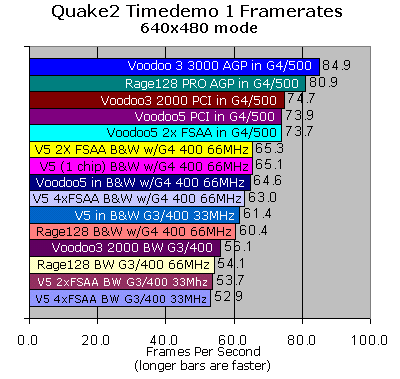
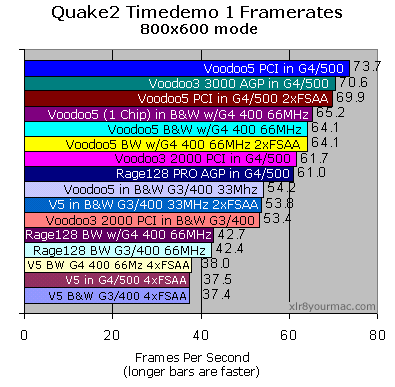
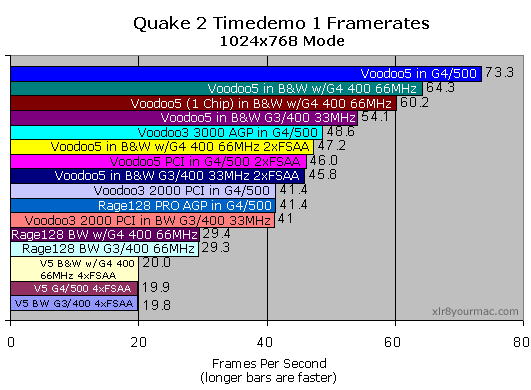
Quake2 Crusher Demo Results: Crusher is a popular demo used to stress test your system in Quake2 to provide a more accurate performance indication from intense deathmatch play than the built-in timedemos.
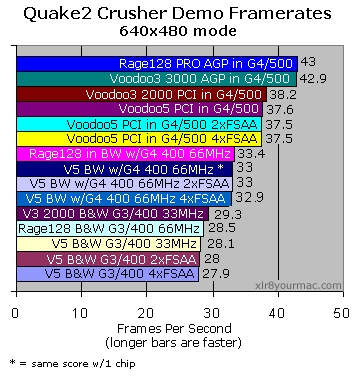
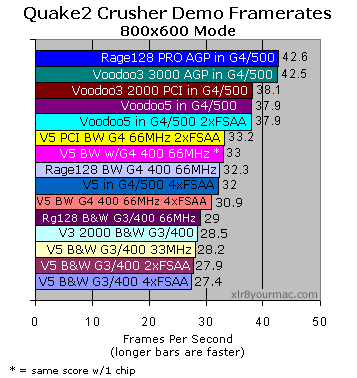
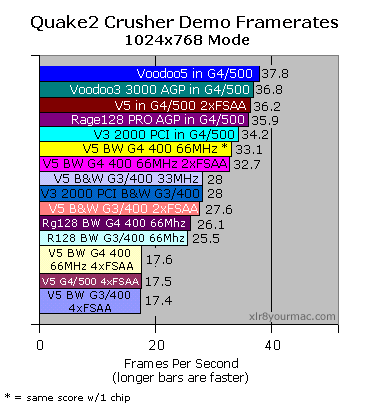
At 1024x768 the Voodoo5 finally shows an advantage, running 2xFSAA at nearly the rate of a V3 3000 AGP (66mhz slot). If you noted the similarity of FSAA scores to non-FSAA, you can understand why I retested several times before daring to post such results. (I wouldn't have believed it if I had not seen it personally.)
Quake 3: Quake 3 scores were the most baffling in many cases. Often the dual chip Voodoo5 was slower than a Voodoo3 in the same system. Also note how close (often literally identical) the Voodoo5 scores are with one chip vs the default 2 chip setting. Note that 2xFSAA was nearly as fast as non-FSAA in 640x480 mode. Again the Mac system/CPU design doesn't deliver the data to the card fast enough to fully saturate the card, but the results still were puzzling. I can only assume this driver or firmware revision is to blame. [Due to time pressure I wasn't able to graph the results, but did list them by system. Grouped as one graph from fastest to slowest was more confusing in my opinion.] Other than the Locki config results farther down - Quake 3 had all the default quality options on (Lightmap lighting, high geometric detail, marks on walls, dynamic lighting, etc. ON).
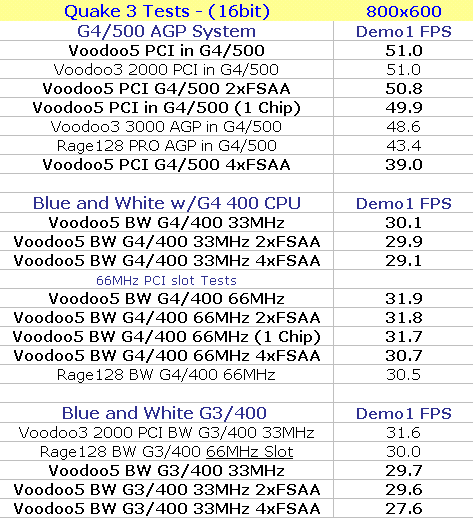
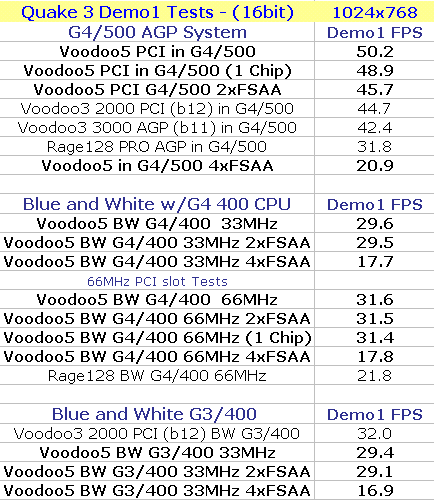
(Voodoo3 not in the list as it can't run 32bit mode)
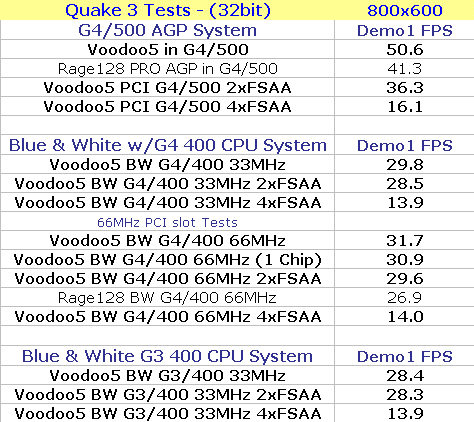
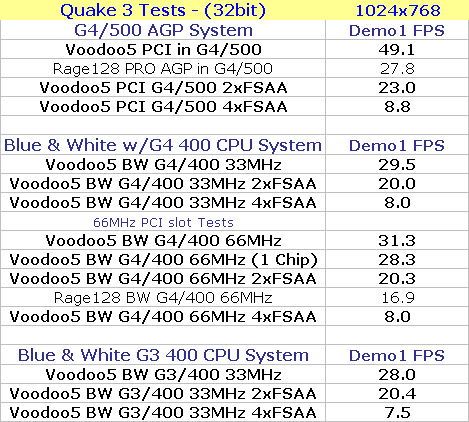
Quake3 Locki.cfg Results:
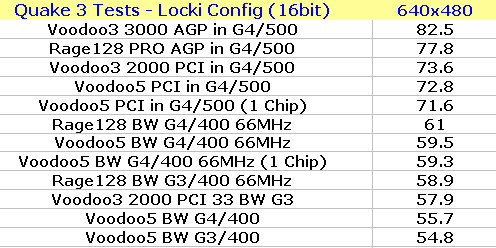
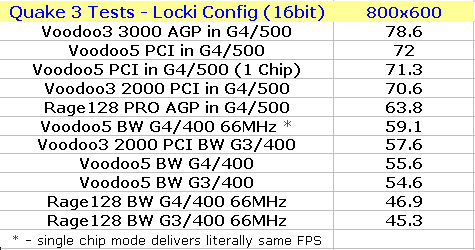
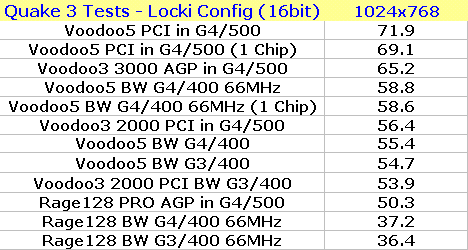
Note: Since the 9500 tests were done at the last minute before publishing this review, I later did some further tests. I'm not sure if the older Mac hardware (PCI/Memory controller, etc.) or the Voodoo5 driver/ firmware is responsible for the fact that only one VSA100 chip seems to be fully functional. However it's clear after testing 4xFSAA in Pod Racer and from temperature tests of the two VSA100 chips that only one is really working when the card is in my 9500. (I suspect other pre-Beige G3 models would show the same results. Note: Readers with 7500, 8500 and 9600 Macs have reported that only 1 chip is fully functional in these systems also.) This explains why the 4xFSAA results in the 9500 were faster than 4xFSAA tests in the B&:W G3 and G4/500. Both VSA100 chips get hot when running in the B&W G3, Beige G3 and G4 Systems, whereas only one does in the 9500. Note: This issue still exists in the 1.01 drivers/1.31 ROM update released in early August. Using Pod Racer as a test with the driver/ROM update, it appears that 2XFSAA is working in the 9500, but 4XFSAA doesn't show any visual benefit in the 9500. 4xFSAA requires both VSA100 chips to be operating, whereas 1 chip can perform 2xFSAA. Again I'm not sure if this issue can be fixed in a future firmware/driver update, but I wanted owners of older Mac models (pre-Beige G3) to be aware that as of driver v1.01/ROM 1.3.1 at least, there's no benefit from using a Voodoo5 vs. the lower cost single chip Voodoo4 card (due to be available in September at an estimated price of under $200).
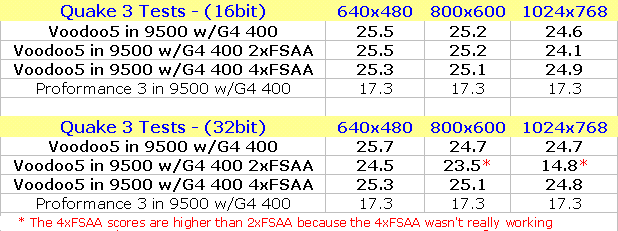
v1.08 Driver/ROM Update Tests (9/22/2000): I've tested the new 1.08 Voodoo5 drivers in my Genesis (9500 based) system with G4 upgrade. Both VSA100 chips are working now. I ran tests at 1024x768, 32bit mode before and after the update. Before the update the 4xFSAA mode was not working (same FPS as 'fastest performance'). After the update the 4xFSAA scores at 1024x768 were the same as my B&W G3 with a G4/400 upgrade running the Voodoo5 in a 66MHz PCI slot. Both systems were tested with the new drivers. The B&W G3 showed basically zero gain from the drivers, but the card in the G4/400 upgraded Genesis showed a small gain at 'fastest' mode, but appx. 30% gain at 2xFSAA mode now that the 2nd chip is enabled. Here are the scores from the Genesis. Quake3 32bit settings were high geometric detail, etc. and all game options on (except vsync):
* exact same score as seen in B&W G4/400 system in 66MHz slot Remember with the 1.01 drivers 4xFSAA wasn't really enabled, since only one chip was fully functional (4xFSAA requires both chips). So the low score is normal now with 4FSAA functional. For the first time, both VSA100 chips are very hot indicating they are both working. (Update:) Here's a comparison of the new drivers comparing the Voodoo5 in the Genesis w/G4 400Mhz (rev 2.2 G4 CPU w/1MB cache) vs the B&W System (66MHz slot) w/G4 400Mhz (rev 2.2 G4 CPU w/2MB cache) at 640x480, 32bit mode:
Unreal Tournament: (9/16/2000 update - The following is from tests done during my review of the MetaBox G4/450 2MB ZIF upgrade since I could not find my notes from past tests.) The 'cityintro' timedemo was run in Unreal Tournament full version with the 425a update applied. All tests were run at 640x480 (the tests were done as part of a CPU upgrade review, to show what benefit the CPU upgrade provided and higher resolutions would have the Rage128 fill rate become a factor). OpenGL and Rave tests were run at 32bit mode with medium detail, and low audio quality, with a "min desired framerate" set to 0. Dynamic lighting was enabled. All results are in frames-per-second, higher is better. Since the UT's timedemo stats reports min, max and average framerates, all are listed below. The Cityintro test is basically a flyby with no firing, etc. so I also included the Wicked400 demo torture test as well. Scores with Wicked400 have always been very low even with the fastest Macs I have. One important note I wanted to make about the OpenGL scores. I had problems applying the 425a update and ended up performing a clean install and then applying the patches. I didn't realize until preparing to run the G4/AGP system tests that I had not reset UT to my normal 150MB allocated RAM setting (Westlake notes OpenGL mode requires more RAM). Had I noticed this sooner I would have re-tested (I thought I had reset UT to 150MB). The 107MB default UT allocation may have affected OpenGL scores somewhat with the Rage128 cards but a repeat of the Cityintro and Wicked400 tests on the G4/500 AGP with 150MB allocated showed scores were literally the same, with a max of 0.5 fps gained from the additional RAM allocation with the Cityintro test and only 0.2 FPS avg gain on the Wicked400 OpenGL mode test (at least on that system/video card combo). The Voodoo5 PCI card however, would lock up quickly in UT with only 107MB RAM allocated, so scores in the table for the Voodoo5 were with 150MB allocated. (Glide mode ran fine with 107MB allocated to UT, but since that's 16bit mode the results are not show in the table (but are farther down in the text).
Wicked400 is a recorded demo with intense action, weapons firing, multiple players, etc. and is used to show perhaps worst case framerates during actual play.
Like many of the other results from this review, performance was disappointing with the current drivers (1.01 drivers, 1.31 ROM used for the UT tests). As you can see above, in some cases a Rage128 was faster at 640x480 modes than the Voodoo5. (Granted at higher resolutions the fill rate limits of the Rage128 would cause FPS to drop, where the Voodoo5 card would stay relatively flat from 640x480 to 1024x768). Since it wouldn't be fair to include 16-bit Glide mode tests in comparison to the 32Bit modes above but for those that are interested Glide mode results with the V5 and the G4/450 CPU upgrade, here they are: Voodoo5 Glide (16Bit) Results w/G4/450 2MB Upgrade: As I commented on orignally, UT scores seem very similar regardless of video card, at least at 640x480 modes where fill rate of the chip does not come into play.
The next tests I ran dealt with movie playback. |
|||||||||||||||||||||||||||||||||||||||||||||||||||||||||||||||||||||||||||||||||||||||||||||||||||||||||||||||||||||||||||||||||||||||||||||||
|
|
|||||||||||||||||||||||||||||||||||||||||||||||||||||||||||||||||||||||||||||||||||||||||||||||||||||||||||||||||||||||||||||||||||||||||||||||
|
Intro | 2D Performance | 3D Performance | Game Performance | Movie Playback | Controls/Design | Summary - or - |
|||||||||||||||||||||||||||||||||||||||||||||||||||||||||||||||||||||||||||||||||||||||||||||||||||||||||||||||||||||||||||||||||||||||||||||||
|
All brand or product names mentioned here are properties of their respective companies. Site terms and conditions of use. |
|||||||||||||||||||||||||||||||||||||||||||||||||||||||||||||||||||||||||||||||||||||||||||||||||||||||||||||||||||||||||||||||||||||||||||||||

